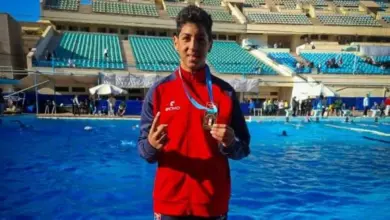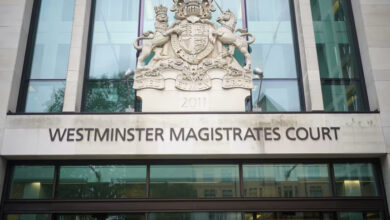In his 18 years as a television news director, Ayman al-Habbal can’t remember covering a single event that compares with Mubarak's trial. “Maybe when they moved the Ramses statue to its new location,” he says. “But that’s as close as it gets, and it’s not very close at all.”
On 3 August, former President Hosni Mubarak was rolled into a courthouse on a gurney to face charges of the intentional killing of protesters during the 25 January uprising. Also present and facing similar counts were his two sons, Gamal and Alaa, and former Interior Minister Habib al-Adly, along with six of his assistants. The event was as unprecedented as it was unexpected – even though the date had been set in advance, most sources predicted Mubarak would fail to show up.
After months of protests demanding that the trials be public and transparent, the ruling military council agreed to air them on Egyptian state TV, where Habbal works. The historic trial captivated audiences around Egypt and the world, but Habbal, 45, wasn’t “that interested in the actual events.”
He had more immediate concerns, namely, directing the event’s live broadcast. “My priorities were based on the technicalities of filming the actual trial, so I was more concerned with the visual information rather than what was being said,” Habbal explains. “As director, I had to be certain that we [the news team] captured absolutely everything, every movement the defendants made, every gesture and whispered conversation between them.”
“Our team had exclusive rights to this event, and the rest of the world would be using our footage, so we had to make sure we got it right,” says Habbal. “Not to mention the fact that this was an actual historic occasion, not a movie. You only have one shot at capturing it before it’s gone.”
Crucial to capturing events in their entirety – subtle gestures and side conversations included – was the news crew’s preparation process. During the days leading up to the trial, Habbal and his team visited the courthouse five times, recording every aspect of it, and doing their best to predict the actual proceedings.
“We filmed every angle of [the courtroom]. We removed the projectors they had installed in the ceiling, and replaced them with cameras. Before anyone was allowed to see the courtroom, before photographs of its interior were even released to the media, I had already filmed it extensively on my cellphone camera.”
When Mubarak arrived, Habbal and his team were as prepared as they could be, although the director insists, “If I could have had a camera in Mubarak’s cage, I would have.”
Besides the security measures and legalities that prevented Habbal from setting up an in-dock camera, the director’s attempts to capture the disgraced former president on film were repeatedly marred by Mubarak’s sons, who, at their father’s prodding, did their best to block the camera.
“Obviously, we anticipated that Mubarak would try to avoid being filmed,” says Habbal. “So we placed three cameras around his cage. Every time one of his sons would get in the way, we would immediately cut to another angle.”
The nine other cameras used to cover the first session of the trial were situated in various strategic locations in and around the courtroom, including one on a crane that would occasionally glide over the proceedings. “I thought it would be a good angle to use during breaks, or for establishing shots,” Habbal explains. “Again, I wanted to film as much as I could, as differently as I could. I would have liked to continue filming during the break for deliberations, to film the actual deliberation. I’d even have gone as far as putting cameras in the courthouse bathrooms.”
As historic as the ongoing trial may be, Habbal’s determination to capture as much as he can is a result of more than just his appreciation of the event’s unprecedented nature. In some ways, it can be seen as an act of redemption. Pre-revolution news coverage was “nothing but red tape and restrictions, everywhere and with everything. Your priorities were already predetermined by the powers that be, and our agendas fixed,” he says.
Habbal is appreciative that the restrictions have eased. “We have had the full support of the Interior Ministry and the authorities in covering this trial,” the director says. “They’ve given us complete access to everything we’ve needed, and they let us do whatever we need to do, as long as it doesn’t interfere with the legal process.”
And while that one restriction prevents Habbal’s team from placing a camera directly in the former president’s face, it has allowed for other close encounters. “We got close enough to the Mubaraks on their way out [of the courthouse] that Alaa was able to reach out and push one of our cameras away,” he says.
Having since had time to watch the tapes of the preliminary session – which also helped prepare him for covering the following trials, including Habib al-Adly’s hearing on 4 August – Habbal feels he can comment on last week’s proceedings. When asked about expectations, Habbal asserts that he had none (“news directors never have expectations”) but admits: “When the trial date was set, like a lot of people, I wasn’t so sure if Mubarak would attend his own trial. However, when we got news that a helicopter had landed at the Sharm el-Sheikh hospital where he’s been staying, one day before the trial was scheduled to start, we all started to believe that he might actually show up.”
Much has been made of the events of 3 August, and the abundance of related conspiracy theories has surprised few. And despite debates about the former president’s demeanor and appearance, even down to the tone of his voice and degree to which his hair is dyed, it was one faux-pas that seemed to grip the public’s attention more than anything else.
“Yeah, a lot of people claim that the fact that he repeatedly picked his nose proves that the man on trial isn’t Hosni Mubarak, that it’s some imposter or double,” laughs Habbal. “But my colleagues and I will tell you, after years of extensively covering Mubarak, that the nose-picking proves beyond the shadow of a doubt that the man on trial is, in fact, the former president.”




